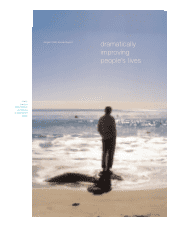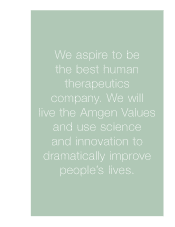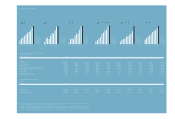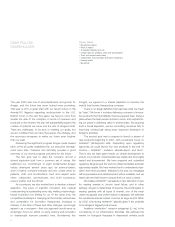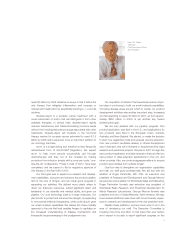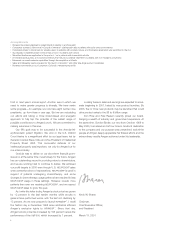Amgen 2000 Annual Report Download - page 6
Download and view the complete annual report
Please find page 6 of the 2000 Amgen annual report below. You can navigate through the pages in the report by either clicking on the pages listed below, or by using the keyword search tool below to find specific information within the annual report.
5
Kevin W. Sharer
Chairman,
Chief Executive Officer,
and President
reach $3 billion by 2005. Anakinra is unique in that it will be the
only therapy that mitigates inflammation and reverses or
reduces joint destruction by specifically blocking IL-1, a pivotal
cytokine.
Abarelix-depot is a prostate cancer treatment with a
novel mechanism of action that will distinguish it from other
available therapies. In clinical trials, abarelix-depot rapidly
reduces testosterone and follicle-stimulating hormone levels
without the troubling testosterone surge associated with other
treatments. Abarelix-depot will compete in the hormonal
therapy market for prostate cancer estimated to reach $1.5
billion by 2005 and is expected to be an important addition to
our oncology franchise.
SD/01 is a longer-acting and therefore a less-frequently
administered form of NEUPOGEN® (Filgrastim). We expect
SD/01 to help more people successfully get through
chemotherapy and stay out of the hospital by making
protection from infection simpler with a once-per-cycle, “one-
size-fits-all” configuration. Phase 3 trials of SD/01 have been
completed, and we expect to file for regulatory approval of
this therapy in the first half of 2001.
Our third goal was to expand our research and develop-
ment capabilities, and grow and advance the product pipeline.
R&D is the core of Amgen, and we made good progress in
expanding our activities. We defined more clearly where to
direct our discovery resources, added significant talent and
leadership to our scientific and medical staffs, and grew our
pipeline. Our core technology base is in large molecules. Our
plan is both to protect and enhance this strength, by expanding
to monoclonal antibody therapeutics, while continuing to grow
our small molecule capabilities. We believe this three-modality
approach is the one that best enables Amgen to capitalize on
the increased understanding of disease mechanisms and
therapeutic targets emerging in the postgenomic era.
Our acquisition of Kinetix Pharmaceuticals was an impor-
tant step in continuing to build our small molecule capabilities.
Choosing disease areas around which to cluster our product
development activities was another important step. Increasing
our R&D spending to nearly $1 billion in 2001, up from approx-
imately $850 million in 2000, is yet another key toward
achieving this goal.
We are very pleased with our pipeline progress. One
product application was filed in the U.S., and applications for
two products were filed in the European Union, Canada,
Australia, and New Zealand. We started, or made the decision
to start, four registration trials and received one line extension.
One new product candidate already in clinical development
was in-licensed, and we in-licensed or acquired another eight
research and preclinical projects. We plan in 2001 to begin five
new product-registration and label-extension trials and file two
new-product or label-extension applications in the U.S. and
other countries. Also, we continue aggressive efforts to acquire
product opportunities from outside Amgen.
Goal four was to strengthen our organization capabilities
and help our staff grow professionally. We did this with the
addition of Roger Perlmutter, MD, PhD, as executive vice
president of Research and Development and George Morrow
as executive vice president of Worldwide Sales and Marketing.
Roger Perlmutter formerly was executive vice president of
Worldwide Basic Research and Preclinical Development for
Merck Research Laboratories. George Morrow formerly was
president and CEO of GlaxoWellcome, North America. We also
hired several additional executives with broad industry experi-
ence in research and development at the vice president level.
Despite these additions, we have more work to do in the
area of developing our staff. The Executive Committee is
focusing more time and effort on this issue than ever before,
and I expect to be able to report significant progress on this

